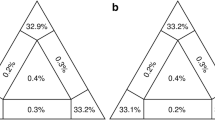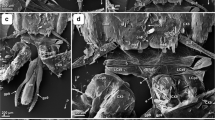Abstract
In Opiliones, male genital morphology plays a key role in systematics and understanding the evolution of the group because functional modifications often outline higher taxonomic levels. In Nemastomatidae, different lateral stabilizing structures on the penial truncus cane developed independently. These wing-like protuberances serve as anchor points for two muscular tendons and are interpreted traditionally as generic characters. A newly discovered species from Monte Saccarello in the Ligurian Alps of North-western Italy is unique in providing anchor points as stabilizing parts of the distal truncus cane below the glans by short and narrow lateral folds. To place this unusual species within the Nemastomatidae one must re-evaluate the usefulness of male genital morphological and other characters used in the systematics of the family. The resulting phylogenetic framework is supplemented with available molecular genetic data. Based on both datasets, the creation of a new genus seems justified. Saccarella schilleri gen. n. sp. n. is subsequently described and further defined. The endemism and biogeography of the harvestmen fauna in the South-western Alps are discussed with respect to this enigmatic genus.




Similar content being viewed by others
References
Ausserer, A. (1867). Die Arachniden Tirols nach ihrer horizontalen und verticalen Verbreitung. Verhandlungen der Zoologisch-Botanischen Gesellschaft in Wien, 17, 137–170.
Casazza, G., Zappa, E., Mariotti, M. G., Médail, F., & Minuto, L. (2008). Ecological and historical factors affecting distribution pattern and richness of endemic plant species: the case of the Maritime and Ligurian Alps hotspot. Diversity and Distributions, 14, 47–58.
Diadema, K., Bretagnolle, F., Affre, L., Yuan, Y. M., & Médail, F. (2005). Geographic structure of molecular variation of Gentiana ligustica (Gentianaceae) in the Maritime and Ligurian regional hotspot, inferred from ITS sequences. Taxon, 54, 887–894.
Dresco, E. (1952). Étude du genre Sabacon (Opiliones). Annales de la Société Entomologique de France, série 6, 121, 117–126.
Giribet, G., Vogt, L., Pérez González, A., Sharma, P., & Kury, A. B. (2010). A multilocus approach to harvestman (Arachnida: Opiliones) phylogeny with emphasis on biogeography and the systematics of Laniatores. Cladistics, 26, 408–437.
Gruber, J. (1976). Ergebnisse zoologischer Sammelreisen in der Türkei: Zwei neue Nemastomatidenarten mit Stridulationsorganen, nebst Anmerkungen zur systematischen Gliederung der Familie (Opiliones, Arachnida). Annalen des Naturhistorischen Museums in Wien, 80, 781–801.
Gruber, J. (1979). Ergebnisse zoologischer Sammelreisen in der Türkei. Über Nemastomatiden-Arten aus der Verwandschaft von Pyza aus Südwestasien und Südosteuropa (Opiliones, Arachnida). Annalen des Naturhistorischen Museums in Wien, 82, 559–577.
Gruber, J., & Martens, J. (1968). Morphologie, Systematik und Ökologie der Gattung Nemastoma C. L. Koch (s. str.) (Opiliones, Nemastomatidae). Senckenbergiana biologica, 49, 137–172.
Huelsenbeck, J. P., & Ronquist, F. (2001). MRBAYES: Bayesian inference of phylogeny. Bioinformatics, 17, 754–755.
Isaia M., Paschetta, M., Lana, E., Pantini, P., Schönhofer, A.L., Christian, E., & Badino, G. (2011). Aracnidi sotterranei delle Alpi Occidentali italiane (Arachnida: Araneae, Opiliones, Palpigradi, Pseudoscorpiones)/ Subterranean Arachnids of the Western Italian Alps (Arachnida: Araneae, Opiliones, Palpigradi, Pseudoscorpiones). Monografie del Museo Regionale di Scienze Naturali, Torino, Italy.
Koch, C. L. (1836). Die Arachniden getreu nach der Natur abgebildet und beschrieben (Vol. 3). Nürnberg: C. H. Zeh'schen Buchhandlung.
Kratochvíl, J. (1958). Höhlenweberknechte Bulgariens (Palpatores—Nemastomatidae). Práce Brněnské základny Československé akademie věd, Brno, 30(12), 523–576.
Martens, J. (1969). Die Abgrenzung von Biospezies auf biologisch-ethologischer und morphologischer Grundlage am Beispiel der Gattung Ischyropsalis C. L. Koch 1839 (Opiliones, Ischyropsalididae). Zoologische Jahrbücher Abteilung für Systematik, 96, 133–264.
Martens, J. (1973). Feinstruktur der Chelieren-Drüse von Nemastoma dentigerum Canestrini (Opiliones, Nemastomatidae). Zeitschrift für Zellforschung und mikroskopische Anatomie, 136, 121–137.
Martens, J. (1976). Genitalmorphologie, System und Phylogenie der Weberknechte (Arachnida: Opiliones). Entomologica Germanica, 3(1/2), 51–68.
Martens, J. (1978). Spinnentiere, Arachnida—Weberknechte, Opiliones. Die Tierwelt Deutschlands, 64, 1–464.
Martens, J. (1983). Europäische Arten der Gattung Sabacon Simon 1879 (Arachnida: Opiliones: Sabaconidae). Senckenbergiana biologica, 63(3/4), 265–296.
Martens, J. (1986). Die Grossgliederung der Opiliones und die Evolution der Ordnung (Arachnida), in: Barrientos, J.A. (Ed.), Actas del X Congreso Internacional de Aracnologia (Jaca, Spain), vol. 1 (pp. 289–310), Barcelona.
Martens, J. (2006). Weberknechte aus dem Kaukasus (Arachnida, Opiliones, Nemastomatidae). Senckenbergiana biologica, 86(2), 145–210.
Martens, J. (2011). The Centetostoma scabriculum complex – a group of three cryptic species (Arachnida: Opiliones: Nemastomatidae). Zootaxa, 2783, 35–51.
Martens, J., & Chemini, C. (1988). Die Gattung Anelasmocephalus Simon, 1879. Biogeographie, Artgrenzen und Biospezies-Konzept (Opiliones: Trogulidae). Zoologische Jahrbücher Systematik, 115, 1–48.
Martens, J., & Schawaller, W. (1977). Die Cheliceren-Drüsen der Weberknechte nach rasteroptischen und lichtoptischen Befunden (Arachnida: Opiliones). Zoomorphologie, 86, 223–250.
Maurer, R., & Thaler, K. (1988). Über bemerkenswerte Spinnen des Parc National du Mercantour (F) und seiner Umgebung (Arachnida: Araneae). Revue Suisse de Zoologie, 95, 329–353.
Mayr, E. (1942). Systematics and the Origin of Species from the Viewpoint of a Zoologist. New York: Columbia University Press.
Mello-Leitao, C. (1936). Les Opilions de Catalogne. Treballs del Museo de Ciències Naturals, Barcelona (ser. Entomol.), 11(9), 1–18.
Pawlowski, B. (1970). Remarques sur l’endémisme dans la flore des Alpes et des Carpates. Vegetatio, 21, 181–243.
Posada, D. (2008). jModelTest: Phylogenetic model averaging. Molecular Biology and Evolution, 25, 1253–1256.
Prieto, C. E. (2004). El género Nemastomella Mello-Leitão 1936 (Opiliones: Dyspnoi: Nemastomatidae) en la Península Ibérica, con descripción de la primera especie de Andalucía. Revista Ibérica de Aracnología, 9, 107–121.
Rambla, M. (1969). Una n. sp. del gen. Nemastoma, grupo bacilliferum de la Peninsula Ibérica (Opiliones, Fam. Nemastomatidae). Publicaciones del Instituto de Biologica aplicada, 47, 89–96.
Rambla, M. (1983). Sobre los Nemastomatidae (Arachnida, Opiliones) de la Península Ibérica. VI. Acromitostoma rhinocerus y Acromitostoma hispanum (nueva combinación). Speleon, 26(27), 21–27.
Redikorzev, V. V. (1936). Materialy k faune Opiliones SSSR - Beiträge zur Opilioniden-Fauna von U.S.S.R. Trudy Zoologiceskogo, 3, 33–57.
Roewer, C. F. (1923). Die Weberknechte der Erde Systematische Bearbeitung der bisher bekannten Opiliones. Fischer: Jena.
Roewer, C. F. (1951). Über Nemastomatiden. Weitere Weberknechte XVI. Senckenbergiana, 32(1/4), 95–153.
Ronquist, F., & Huelsenbeck, J. P. (2003). MRBAYES 3: Bayesian phylogenetic inference under mixed models. Bioinformatics, 19, 1572–1574.
Ronquist, F., Huelsenbeck, J.P. & van der Mark, P. (2005). MrBayes 3.1 Manual, Draft 5/26/2005, online at http://mrbayes.csit.fsu.edu/manual.php. Accessed 20 August 2011).
Schönhofer, A. L., & Martens, J. (2010). Hidden Mediterranean diversity: Assessing species taxa by molecular phylogeny within the opilionid family Trogulidae (Arachnida, Opiliones). Molecular Phylogenetics and Evolution, 54(1), 59–75.
Shear, W. A., & Gruber, J. (1983). The opilionid subfamily Ortholasmatinae (Opiliones, Troguloidea, Nemastomatidae). American Museum Novitates, 2757, 1–65.
Šilhavý, V. (1956). Sekáči [Harvestmen - Opilionidea]. Fauna ČSR, 7, 1–272.
Šilhavý, V. (1966). Über die Genitalmorphologie der Nemastomatidae (Arach., Opiliones). Senckenbergiana biologica, 47(1), 67–72.
Simon, E. (1879). Les Arachnides de France. Contenant les ordres des Chernetes, Scorpiones et Opiliones. Paris: Librairie Encyclopédique de Roret, Tome 7.
Simon, E. (1881). Arachnides nouveaux ou rares de la faune française. Bulletin de la Société Zoologique de France, 6, 82–91.
Snegovaya, N. Y. (2010). New Harvestman Genus and Species from Kyrgyz Republic (Kyrgyzstan) (Arachnida: Opiliones: Nemastomatidae). Acta Zoologica Bulgarica, 62(3), 351–354.
Staręga, W. (1976). Die Weberknechte (Opiliones, excl. Sironidae) Bulgariens. Annales Zoologici (Polska Akademia Nauk), 33(18), 287–433.
Staręga, W. (1978). Katalog der Weberknechte (Opiliones) der Sowjet-Union. Fragmenta Faunistica, 23(10), 197–234.
Stoch F., & Vigna Taglianti, A. (2005). I corotipi della fauna italiana, in: Ruffo, S., Stoch, F. (Eds.), Checklist e distribuzione della fauna italiana. Memorie del Museo Civico di Storia Naturale di Verona, 2. serie, Sezione Scienze della Vita, 16, 25–28.
Vigna Taglianti, A., Audisio, P. A., Biondi, M., Bologna, M. A., Carpaneto, G. M., De Biase, A., Fattorini, S., Piattella, E., Sindaco, R., Venchi, A., & Zapparoli, M. (1999). A proposal for a chorotype classification of the Near East fauna, in the framework of the Western Paleartic region. Biogeographia, 20, 31–59.
Westwood, J. O. (1874). Thesaurus Entomologicus Oxoniensis or, Illustrations of new, rare, and interesting insects. Oxford: Clarendon.
Acknowledgments
We especially wish to thank Wolfgang Schiller for donating various opilionids among which this unexpected novelty was detected. He further provided information to localize the very spot of his activities and gave detailed ecological information. We also thank Wolfgang Schawaller for kindly establishing contacts with W. Schiller. Marshal Hedin (San Diego, USA), provided access and introduced A.S. to using the BK Lab System used for taking the images in Figs. 11, 13 and 14. Robert Keith (San Diego, USA) helped to improve the English. The Feldbausch and Wagner Foundation, both at the Fachbereich Biologie, Mainz University, provided grants for field activities to J.M. Presently, A.S. is funded by a postdoc grant of the Deutsche Forschungsgemeinschaft (DFG) to work on systematics and biogeography of holarctic Opiliones. He received an EDIT/ATBI + M travel grant for research in the South-western Alps in 2008. ATBI + M (All Taxa Biodiversity Inventory and Monitoring project) aims to provide comprehensive data on the presence and abundance of organisms in outlined biodiversity hotspots in the framework of the European Distributed Institute of Taxonomy: EDIT.
No ethic standards were violated.
Author information
Authors and Affiliations
Corresponding author
Rights and permissions
About this article
Cite this article
Schönhofer, A.L., Martens, J. The enigmatic Alpine opilionid Saccarella schilleri gen. n., sp. n. (Arachnida: Nemastomatidae)—isolated systematic placement inferred from comparative genital morphology. Org Divers Evol 12, 409–419 (2012). https://doi.org/10.1007/s13127-012-0073-7
Received:
Accepted:
Published:
Issue Date:
DOI: https://doi.org/10.1007/s13127-012-0073-7




